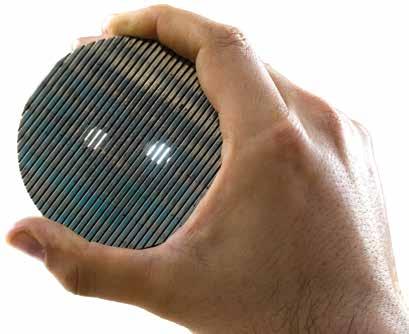
1 minute read
MORE EVIDENCE FOR A STEALTH OCEAN WORLD
When an SwRI scientist discovered surprising evidence that Saturn’s smallest, innermost moon could generate the right amount of heat to support a liquid internal ocean, colleagues began studying Mimas’ surface to understand how its interior may have evolved. Numerical simulations of the moon’s Herschel impact basin, the most striking feature on its heavily cratered surface, determined that the basin’s structure and the lack of tectonics on Mimas are compatible with a thinning ice shell and geologically young ocean.
from Star Wars. If Mimas has an ocean, it represents a new class of small, ‘stealth’ ocean worlds with surfaces that do not betray the ocean’s existence.”
Mimas’ heavily cratered surface suggests a cold history, but its librations rule out a homogeneous interior. Mimas must have a rocky interior and outer hydrosphere, which could include a liquid ocean (A) or be fully frozen with an irregularly shaped core (B). An ocean provides a better fit to the phase of the libration but is difficult to reconcile with Mimas’ geology.

“In the waning days of NASA’s Cassini mission to Saturn, the spacecraft identified a curious libration, or oscillation, in Mimas’ rotation, which often points to a geologically active body able to support an internal ocean,” said SwRI’s Dr. Alyssa Rhoden, a specialist in the geophysics of icy satellites, particularly those containing oceans, and co-author of a new Geophysical Research Letters paper on the subject. “Mimas seemed like an unlikely candidate. Its icy, heavily cratered surface marked by one giant impact crater makes the small moon look like the Death Star
Rhoden worked with Purdue graduate student Adeene Denton to better understand how a heavily cratered moon like Mimas could possess an internal ocean. Denton modeled the formation of the Hershel impact basin using iSALE-2D simulation software. The results imply that a present-day ocean within Mimas must have been warming and expanding since the basin formed.
“Although our results support a present-day ocean within Mimas, it is challenging to reconcile the moon’s orbital and geologic characteristics with our current understanding of its thermalorbital evolution,” Rhoden said. “Evaluating Mimas’ status as an ocean moon would help us better understand Saturn’s rings and midsized moons as well as the prevalence of potentially habitable ocean moons, particularly at Uranus. Mimas is a compelling target for continued investigation.”







